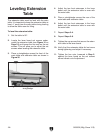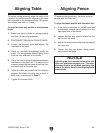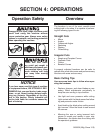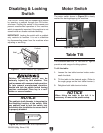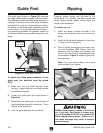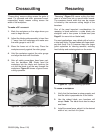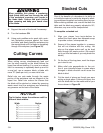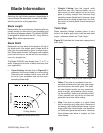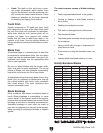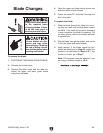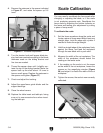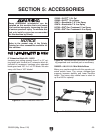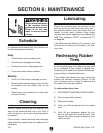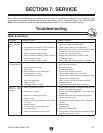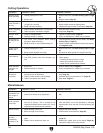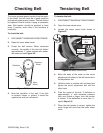
-32-
G0555X (Mfg. Since 1/12)
• Hook: The teeth on this style have a posi-
tive angle (downward) which makes them
dig into the material, and the gullets are usu-
ally rounded for easier waste removal. These
blades are excellent for the tough demands
of resawing and ripping thick material.
Tooth Pitch
Usually measured as TPI (teeth per inch), tooth
pitch determines the size of the teeth. More teeth
per inch (fine pitch) will cut slower, but smoother;
while fewer teeth per inch (coarse pitch) will cut
rougher, but faster. As a general rule, choose
blades that will have at least three teeth in the
material at all times. Use fine pitched blades on
harder woods and coarse pitched blades on softer
woods.
Blade Care
A bandsaw blade is a delicate piece of steel that
is subjected to tremendous strain. You can obtain
longer use from a bandsaw blade if you give it fair
treatment and always use the appropriate feed
rate for your operation.
Be sure to select blades with the proper width,
style, and pitch for each application. The wrong
choice of blades will often produce unnecessary
heat which will shorten the life of your blade.
A clean blade will perform much better than a dirty
blade. Dirty or gummed up blades pass through
the cutting material with much more resistance
than clean blades. This extra resistance also
causes unnecessary heat.
Blade Breakage
Many conditions may cause a bandsaw blade to
break. Blade breakage is unavoidable, in some
cases, since it is the natural result of the peculiar
stresses that bandsaw blades must endure. Blade
breakage is also due to avoidable circumstances.
Avoidable breakage is most often the result of
poor care or judgement on the part of the operator
when mounting or adjusting the blade or support
guides.
The most common causes of blade breakage
are:
• Faulty alignment/adjustment of the guides.
• Forcing or twisting a wide blade around a
short radius.
• Feeding the workpiece too fast.
• Dull teeth or damaged tooth sufficient set.
• Overtensioned blade.
• Top blade guide assembly set too high above
the workpiece.
• Using a blade with a lumpy or improperly fin-
ished braze or weld.
• Continuously running the bandsaw when not
in use.
• Leaving blade tensioned when not in use.
MODEL LENGTH WIDTH TPI GAUGE
G5151 93
1
⁄2"
1
⁄16" 24 Raker 0.025
G5152 93
1
⁄2"
1
⁄8" 14 Raker 0.025
G5153 93
1
⁄2"
1
⁄8" 18 Raker 0.025
G5154 93
1
⁄2"
3
⁄16" 4 Skip 0.025
G5155 93
1
⁄2"
3
⁄16" 10 Raker 0.025
G5156 93
1
⁄2"
3
⁄16" 14 Raker 0.025
G5157 93
1
⁄2"
1
⁄4" 4 Hook 0.025
G5158 93
1
⁄2"
1
⁄4" 6 Hook 0.025
G5159 93
1
⁄2"
1
⁄4" 10 Raker 0.025
G5160 93
1
⁄2"
1
⁄4" 14 Raker 0.025
G5161 93
1
⁄2"
1
⁄4" 18 Raker 0.025
G5162 93
1
⁄2"
3
⁄8" 4 Hook 0.025
G5163 93
1
⁄2"
3
⁄8" 6 Hook 0.025
G5164 93
1
⁄2"
3
⁄8" 10 Raker 0.025
G5165 93
1
⁄2"
3
⁄8" 14 Raker 0.025
G5166 93
1
⁄2"
1
⁄2" 3 Hook 0.025
G5167 93
1
⁄2"
1
⁄2" 4 Hook 0.025
G5168 93
1
⁄2"
1
⁄2" 6 Hook 0.025
G5169 93
1
⁄2"
1
⁄2" 10 Raker 0.025
G5170 93
1
⁄2"
1
⁄2" 14 Raker 0.025
G5171 93
1
⁄2"
3
⁄4" 3 Hook 0.025
G5172 93
1
⁄2"
3
⁄4" 6 Hook 0.025
G5173 93
1
⁄2"
3
⁄4" 10 Raker 0.025
Grizzly Bandsaw Blades



